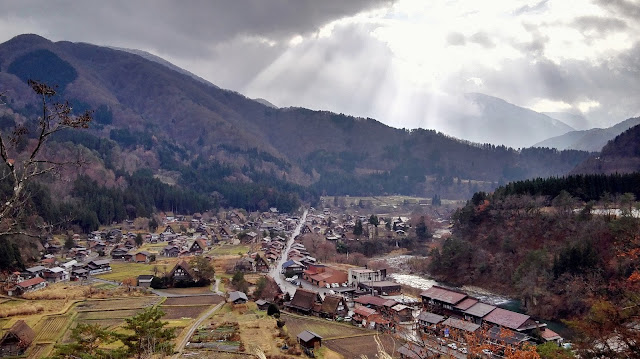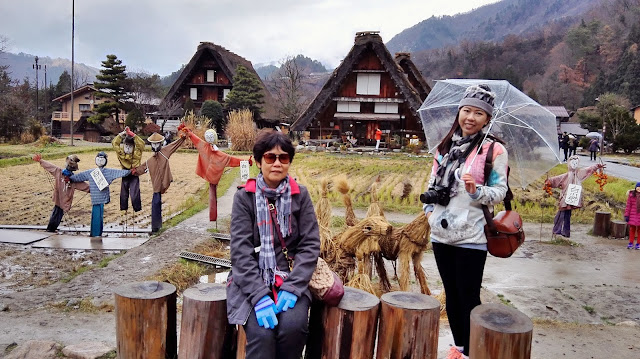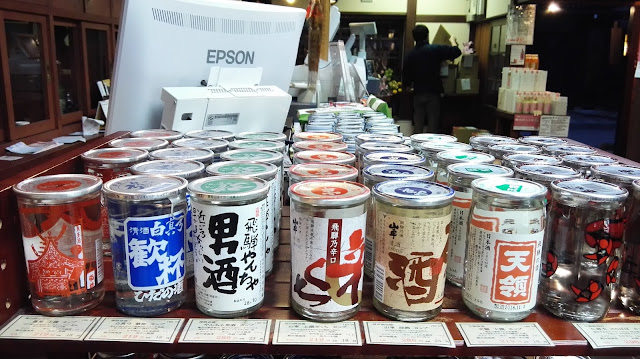After more than four hours ride, we reached Takayama station at 10.30pm. We walked to our accommodation at Takayama Sumiyoshi Ryokan and we were welcomed warmly by an old lady host. Sumiyoshi Ryokan was selected as one of the Top 25 B&Bs and Inns in Japan by TripAdvisor's Travelers' Choice Award 2015. It offers homely Japanese-style accommodation in the historic townhouse building. Rooms are fitted with tatami (woven-straw) flooring and traditional futon bedding. We opted for a Japanese style room with private bathroom and private toilet which costed 9720 yen per person per night.
The old lady led us to the room and served us tea and cookies. She had mistaken there were only two of us and so she started to prepare extra futon while we were settling down. It was embarrassing to watch an old lady working hard so we offered help. It was a busy night for her as she kept coming in and out to/from our room. First to prepare the futon, second to get the passport from us, third round to return the passport.

It has a spacious public bath and a small bath in our room. You can lock the public bath and use it privately.
There are many antiques like pots at many corners and samurai armours displayed at the lobby.
The next morning, we joined tour from Japanican to Gokayama Ainokura and Shirakawago. Both are World Heritage sites with steep-roofed traditional houses, also known as gasshō-zukuri.
The primary purpose of shaping roofs in such way was to accommodate the extensive precipitation experienced in many parts of Japan. A steeply peaked roof allows rain and snow to fall straight off, preventing water from getting through the roof into the home and, to a lesser extent, preventing the thatch from getting too wet and beginning to rot.
The interior of a minka was generally divided into two sections: a floor of compacted earth, called doma (土間) and a raised floor (generally around 20 inches (50 cm) above the level of the doma) covered in tatami or mushiro mats.Large farmhouses sometimes had a raised, timber floored internal veranda (hiroshiki (広敷)) that separated the doma and the tatami areas. In older houses like the 17th century Yoshimura house this separating zone was up to 2.5 m wide and servants apparently slept there.
The raised floor often included a built-in hearth, called an irori (囲炉裏). Above the ash-filled hearth would hang a kettle suspended from the ceiling by an adjustable hearth hook made of wood, metal and bamboo. This jizai kagi (自在鈎) could be raised or lowered depending on the amount of heat required and was often shaped into decorative fish or blade shapes. There was no chimney in the farmhouse and the smoke from the irori would rise through the roof drying the reeds and deterring insects. The irori was the centre of communication for the house where the family gathered to chat and eat, and it was a cozy place around which to sleep. (Wikipedia)
Musical instrument
We first visited Ainokura Village at Gokoyama. The oldest thatched roof house here was built in the 17th century.
We had local lunch at Tenshukaku, the only restaurant that offers panoramic views of Shirakawago. The lunch looked simple and plain but it was healthy and satisfying, especially the tofu dipped in the hot miso sauce which warmed us a lot in a cold rainy day.
After lunch, we headed to Shirakawago. Shirakawago was registered as a World Heritage Site in 1995. There are 114 thatched roof houses here in nostalgic scenery. We had 2 hours free time on our own here.
Around 3pm we arrived back in Takayama. We visited the old town before going back to our hotel.

Rice crackers with different flavors.
Expensive but not impressive
Sarubobo (さるぼぼ) is a Japanese amulet, particularly associated with the town of Takayama in Gifu Prefecture. Sarubobos are red human-shaped dolls, with no facial features, made in a variety of sizes. Traditionally, sarubobos are made by grandmothers for their grandchildren as dolls, and for their daughters as a charm for good marriage, good children and to ensure a well-rounded couple.
Sarubobo dolls and charms usually have no facial features. The reasons for this are unclear, but some have been suggested. One suggestion is that, originally, sarubobos were made from left over cloth and made by relatives, so there was no need for them to be completely accurate.
Another suggestion is that the absence of a face allows the owner to imagine it - when the owner is sad, they can imagine their sarubobo to be sad too. A common tale told by the people of Takayama is that the facelessness is the result of the dolls being made during the period of World War II. The mothers knew that these were hard and unhappy times but, did not want to give the dolls sad faces. So they left them faceless. (Wikipedia)
When we reached the hotel, we were once again welcomed but this time it was a different old lady. With the help of hand signs and body language, we talked for a while about dinner serving later. When we entered our room, we were shocked to see our futons missing. Our room was transformed into a tea room. We at first wondered if we entered into the wrong room. Later we realized that most ryokan rooms are set up as minimalist tearooms during the day. The beds will be setup while the guests are out for dinner.
Before dinner, we enjoyed the green tea and cookies.
We didn't take the room with meal options initially and only decided to experience the Japanese style dinner in the ryokan for the second night upon arrival. The dinner was 3000 yen per person. We only requested for two pax (with one vegetarian option). The dinner was served in a separate room. It was a shame when the staff offered us more rice when she saw three of us sharing the food.
At night before sleep, we tried the rice wine (I guess) that we bought earlier. We cannot read Japanese but from the label, we can tell it is a product from Shirakawago. It was sweet with very strong fermented smell and I don't like it.
The next morning, we walked to the morning market which was just behind our accommodation. The market was quiet and small. We then walked to the town. Some corners got in the Christmas spirit.

We went back to the bus terminal and traveled to Matsuri no Mori via Sarubobo Bus which provides hourly connection. Matsuri no Mori showcases the key aspects of the Takayama Festival, which takes place for two days each spring and autumn. There are several huge taiko drums, said to be the biggest drums in the world. Visitors are able to enjoy the rich timbre of these percussion instruments through one of the scheduled shows
At the main exhibition space, a number of magnificent, life-sized replica floats are displayed. We had a close view at their elaborate designs, decorations and karakuri dolls. Karakuri are marionettes which are a key feature in the Takayama Festival. They are usually manipulated by puppeteers, but the museum uses machine-operated ones for demonstration performances that are held frequently throughout the day.
We arrived back to Takayama at noon. I "cravingly" looked for beef for lunch before we left the town. Takayama food scene is best known for its high-quality Hida beef which is raised from Japanese black cattle in the region. We did came across with a few restaurants selling hot pot which seemed to be crowded. It was a cold weather and hot pot was the perfect option. However we eventually decided to have more affordable alternatives. We then found this restaurant. Hida beef rice bento was first on my mind but it was pricey (2200 yen) so I decided to have the hida beef noodle instead. Unfortunately we were told all hida beef was sold out for the day. With disappointment, we ended up ordering the wanton noodle and beef don. Food was average, the beef don was too greasy.
I was actually sad during the day when I realized in the morning that I overbooked my accommodation at another place. I do not know how this happened. There was a booking of two nights at another hotel in my Agoda account. And I booked the same two nights at Sumiyoshi Ryokan through email. I probably forgot to cancel one of them before the trip. Sumiyoshi Ryokan was in my itinerary. And I had been mistaking that Sumiyoshi Ryokan was the one I booked in Agoda.
When I returned back to Singapore, I decided to claim refund from Agoda by telling we were not able to go Takayama due to loss of personal belongings. After submitting the police report that we lodged for my mother's lost phone (which did not indicate exactly we only lost a phone) and going through a few phone calls to explain, we managed to get the full refund from Agoda (not the hotel). That saved me a few hundred dollars!!!! I love you Agoda.


























































No comments:
Post a Comment